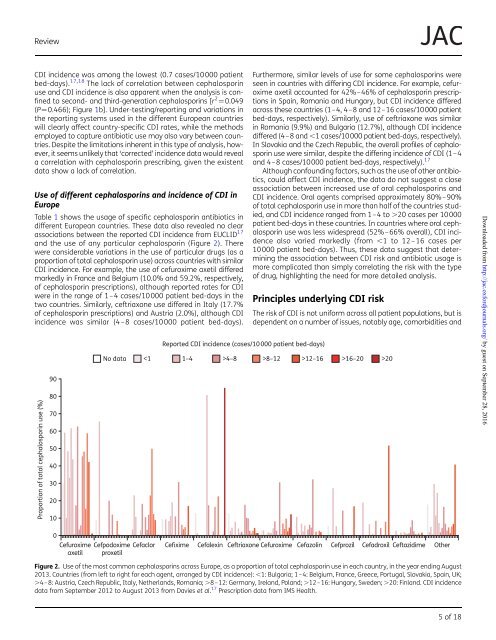http://jac.oxfordjournals.org/
jac.dkw385.full
jac.dkw385.full
You also want an ePaper? Increase the reach of your titles
YUMPU automatically turns print PDFs into web optimized ePapers that Google loves.
Review<br />
JAC<br />
CDI incidence was among the lowest (0.7 cases/10000 patient<br />
bed-days). 17,18 The lack of correlation between cephalosporin<br />
use and CDI incidence is also apparent when the analysis is confined<br />
to second- and third-generation cephalosporins [r 2 ¼0.049<br />
(P¼0.466); Figure 1b]. Under-testing/reporting and variations in<br />
the reporting systems used in the different European countries<br />
will clearly affect country-specific CDI rates, while the methods<br />
employed to capture antibiotic use may also vary between countries.<br />
Despite the limitations inherent in this type of analysis, however,<br />
it seems unlikely that ‘corrected’ incidence data would reveal<br />
a correlation with cephalosporin prescribing, given the existent<br />
data show a lack of correlation.<br />
Use of different cephalosporins and incidence of CDI in<br />
Europe<br />
Table 1 shows the usage of specific cephalosporin antibiotics in<br />
different European countries. These data also revealed no clear<br />
associations between the reported CDI incidence from EUCLID 17<br />
and the use of any particular cephalosporin (Figure 2). There<br />
were considerable variations in the use of particular drugs (as a<br />
proportion of total cephalosporin use) across countries with similar<br />
CDI incidence. For example, the use of cefuroxime axetil differed<br />
markedly in France and Belgium (10.0% and 59.2%, respectively,<br />
of cephalosporin prescriptions), although reported rates for CDI<br />
were in the range of 1–4 cases/10000 patient bed-days in the<br />
two countries. Similarly, ceftriaxone use differed in Italy (17.7%<br />
of cephalosporin prescriptions) and Austria (2.0%), although CDI<br />
incidence was similar (4–8 cases/10000 patient bed-days).<br />
Proportion of total cephalosporin use (%)<br />
90<br />
80<br />
70<br />
60<br />
50<br />
40<br />
30<br />
20<br />
10<br />
Furthermore, similar levels of use for some cephalosporins were<br />
seen in countries with differing CDI incidence. For example, cefuroxime<br />
axetil accounted for 42%–46% of cephalosporin prescriptions<br />
in Spain, Romania and Hungary, but CDI incidence differed<br />
across these countries (1–4, 4–8 and 12–16 cases/10000 patient<br />
bed-days, respectively). Similarly, use of ceftriaxone was similar<br />
in Romania (9.9%) and Bulgaria (12.7%), although CDI incidence<br />
differed (4–8 and ,1 cases/10000 patient bed-days, respectively).<br />
In Slovakia and the Czech Republic, the overall profiles of cephalosporin<br />
use were similar, despite the differing incidence of CDI (1–4<br />
and 4–8 cases/10000 patient bed-days, respectively). 17<br />
Although confounding factors, such as the use of other antibiotics,<br />
could affect CDI incidence, the data do not suggest a close<br />
association between increased use of oral cephalosporins and<br />
CDI incidence. Oral agents comprised approximately 80%–90%<br />
of total cephalosporin use in more than half of the countries studied,<br />
and CDI incidence ranged from 1–4 to .20 cases per 10000<br />
patient bed-days in these countries. In countries where oral cephalosporin<br />
use was less widespread (52%–66% overall), CDI incidence<br />
also varied markedly (from ,1 to 12–16 cases per<br />
10000 patient bed-days). Thus, these data suggest that determining<br />
the association between CDI risk and antibiotic usage is<br />
more complicated than simply correlating the risk with the type<br />
of drug, highlighting the need for more detailed analysis.<br />
Principles underlying CDI risk<br />
Reported CDI incidence (cases/10 000 patient bed-days)<br />
The risk of CDI is not uniform across all patient populations, but is<br />
dependent on a number of issues, notably age, comorbidities and<br />
No data 4–8 >8–12 >12–16 >16–20 >20<br />
Downloaded from <strong>http</strong>://<strong>jac</strong>.<strong>oxfordjournals</strong>.<strong>org</strong>/ by guest on September 28, 2016<br />
0<br />
Cefuroxime<br />
axetil<br />
Cefpodoxime<br />
proxetil<br />
Cefaclor<br />
Cefixime<br />
Cefalexin<br />
Ceftriaxone Cefuroxime Cefazolin<br />
Cefprozil Cefadroxil Ceftazidime Other<br />
Figure 2. Use of the most common cephalosporins across Europe, as a proportion of total cephalosporin use in each country, in the year ending August<br />
2013. Countries (from left to right for each agent, arranged by CDI incidence): ,1: Bulgaria; 1–4: Belgium, France, Greece, Portugal, Slovakia, Spain, UK;<br />
.4–8: Austria, Czech Republic, Italy, Netherlands, Romania; .8–12: Germany, Ireland, Poland; .12–16: Hungary, Sweden; .20: Finland. CDI incidence<br />
data from September 2012 to August 2013 from Davies et al. 17 Prescription data from IMS Health.<br />
5of18




